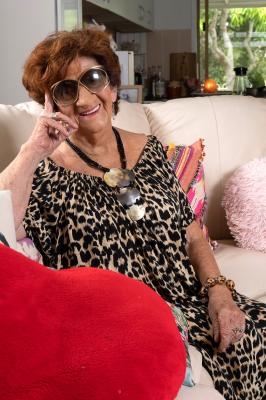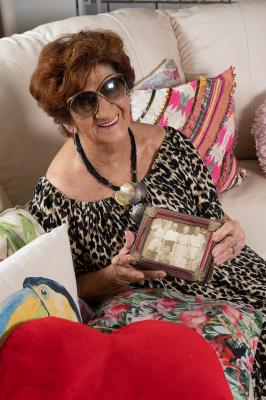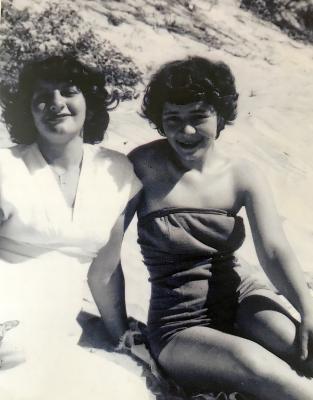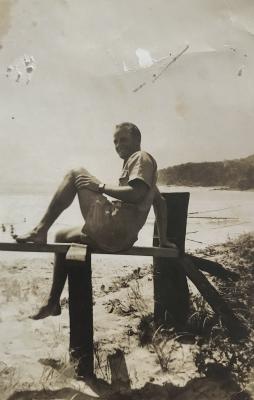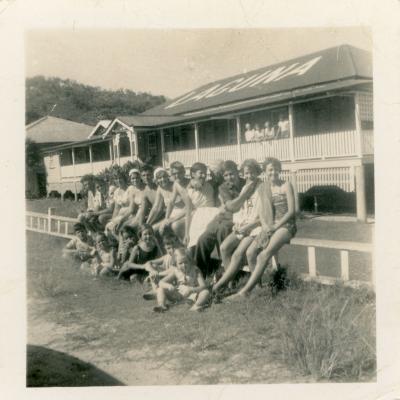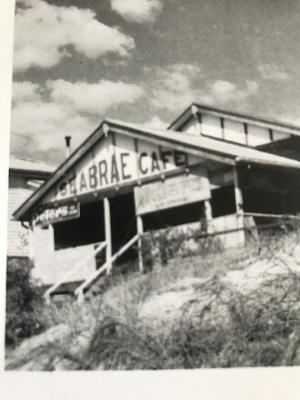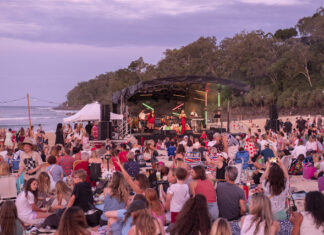One-time Laguna House girl Una Johns remembers the halcyon years of Noosa Heads village.
“When did we decide we didn’t want to live on Hastings Street any longer? When couples started having sex on our front lawn!”
The wonderfully colourful Una Johns, once a Laguna House girl and a belle of Main Beach, tells it like it is, or was. That’s her style, has been since she came down from the hills at 15 with her sister Marie to work at Noosa’s poshest guesthouse, and at 86 she sees no reason to change.
This writer encountered the lady’s frank approach many years ago when the French were exploding nuclear bombs in the Pacific and I foolishly suggested in an allegedly humorous column that people should scratch Peugeots in protest. Alarmed at what might happen to her brand new blue Peugeot, Una Johns rang and gave me a frank lesson in responsible journalism.
I published an apology the following week, which Una pulled out of her clippings file when we finally met in person last week, and we had a good laugh about it. A youthful and charming octogenarian, Una shared stories from her adventurous life, occasionally prompted by daughter Sandra, who grew up on Hastings Street, in the days when you could.
The Hines family were itinerant farmers, so Una and Marie grew up constantly on the move, finding themselves at Tuchekoi in the Noosa hinterland in their early teens during a horrific three-year drought. Says Una: “There was no money coming in so we just had to go out and work.”
Thirteen-year-old Una fibbed about her age and got a job at Gympie’s Northumberland Hotel, where she first made news serving the Queensland governor. Later, she and Marie worked at the Pomona pub before accepting live-in jobs at Laguna House on Hastings Street.
Then in the hands of the Gilchrist family, Laguna House was in its heyday in the late 1940s and ‘50s, a huge establishment that dominated the inlet side of Hastings Street and managed to combine old world charm with a casualness befitting the sand and gravel village. Una recalls: “In those days guests would come up in the train and then get the bus from Cooroy in time for a late lunch that we’d prepare. We’d finish that and then all go swimming and come back of a night for the dinner shift. There were six of us and we had a small wage but we also had our accommodation and meals. A lot of men came down from Gympie and they’d take ‘bachelor pads’ that we had to be careful around when doing the cleaning.“The dining room was very nice and clean. We had to do the silverware twice a week. Guests had the same table year after year, and the same families came back and you got to know them all. I waited on one family from Brisbane who had six children and they always asked for me to serve them. Oh, that was hard.”
Laguna House was always full of interesting characters, and so was the street out front, where John Paterson, “Mr Vita-Tan”, would park his Rolls when he arrived from the Gold Coast, ever eager to rub his mutton bird oil over the Laguna girls when they walked past.
Then there was Pop Calvert, a rich squatter from the Darling Downs who came every year and parked his silver Jag right in front.“We really thought that was something,” Una recalls. “Every Friday all of us six live-in girls would jump in the Jag and Pop would drive us over the hill to where the Junction is now and we’d pick wildflowers for the dining room tables, then come back and do the arrangements. We worked very hard but we also spent plenty of time on the beach, and we had a roster so each of us got a weekend off every few weeks.
“Sometimes of a night we’d go up to Freeman’s farm along the goat track and fill up sugar bags with fruit and vegetable for Laguna and then slide back down the track, where the steps are now. Saturday nights we’d go out to country dances at Kenilworth or Belli in Ken Gilchrist’s big Chevy. He was the boss’s son. Sometimes those dances would go till 3am, and if there wasn’t a fight, it wasn’t a good night.”
At one of the weekend dances, the Hines girls met the Johns boys, and although she wasn’t initially impressed, Una and Ken Johns were soon an item, while Marie took up with Jimmy Johns. A former airman 11 years Una’s senior, Ken was an athletic man with a quiet authority about him, a bit of a dasher. Says Una: “I was in the toilet at one of the dances one night and a girl came in and said to her friend, ‘That Ken Johns can put his shoes under my bed any time.’ That was when I thought I’d better keep an eye on him.”
“I think both Dad and Uncle Jimmy were considered to be very eligible bachelors,” Sandra Johns adds quietly.
The Johns family owned what seemed like half of the beach side of Hastings Street, their interests stretching from Edgar Johns’ Beachview Flats, where Netanya Noosa Resort is now, to Edgar’s Seaview Flats at the edge of The Woods, passing along the way Colin Johns’ Beachcomber Flats, Cyril Johns’ Bayview (later Barry’s Bistro), a family home, the Johns’ Seabrae Caf¨¦ and general store. Edgar also had a dairy farm at Lake Weyba and his eggs, cucumbers and watermelons supplied the town. They were Noosa’s quiet achievers. Says Una: “You have to remember that money meant nothing in Noosa in those days.” Sandra adds: “You ran out of cash, you sold a block of land.”
Within a couple of years, the Johns brothers and the Hines sisters were happily married. Both couples lived on the beachfront and raised their children there in a blissful existence interrupted only occasionally by storms and cyclones, at which time Ken and Jimmy and every other owner on the front would disappear to a quarry and make their own protective rock walls.
Ken and Jim were handy bodysurfers and, watching from their verandas, often swam out to rescue bathers, or reported shark sightings that closed the beach. Ken also ran a hose down from the house to loosen the hard sand save a small child buried at the water’s edge. And in between heroics, business was good and there were the endless family barbeques on the beach, grilling the catch of the day.
But by the 1980s, the real world was starting to catch up with sleepy Noosa – tourists parked in their driveway and abused them when asked to move, laughed when they saw the clothesline in the middle of a famous tourist strip, and there was the odd amorous adventure on the lawn. Plus rates had gone sky high.The brothers sold out in 1987 and Ken and Una bought the house she still lives in near Weyba Creek and took a succession of well-earned world tours. Does she miss it?
“Never. The kids might have a bit, but I’m happy where I am. They drag me down to Bistro C, which is where our house was, for birthday lunches once a year, but that’s enough for me.”
Background information on Noosa in the 1950s is with grateful acknowledgements to Hastings Street, Stories from Noosa’s Past, by Emma Freeman.

